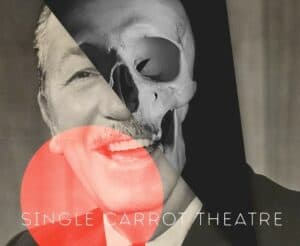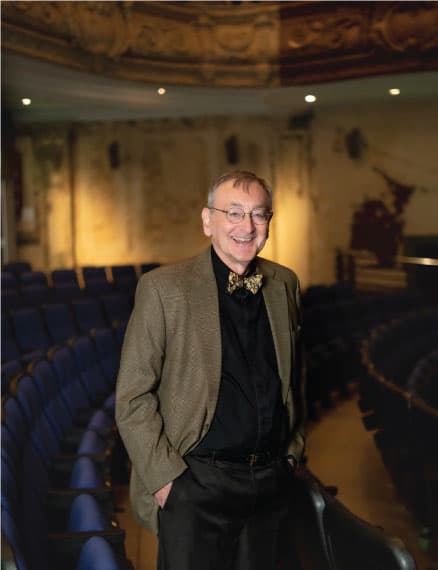No Escape from the Hall of Mirrors in THE DEATH OF WALT DISNEY at Single Carrot Theatre

Posted on the Baltimore page of BroadwayWorld.com February 5, 2018
The ahistorical insinuations begin before we even reach the auditorium, as we are marched down a hallway with a lemming stenciled on the side, which will prove to be a reference to the staged suicides of lemmings in a 1958 Walt Disney nature documentary; the only problem is, as the Snopes fact-checking website tells us: “it is not known whether Walt Disney approved or was aware of the activities of … the principal photographer for the lemmings sequence.”
When the audience arrives in the auditorium, the set immediately previews a clear falsehood: stylized icicles and simulated vapor prefiguring the cryogenic postmortem freezing of Walt Disney‘s head – which is a part of the play, but never happened, though Disney did think about it. (Disney was cremated.) The play lurches along like this, from calumny to calumny.
Lucas Hnath‘s A Public Reading of an Unproduced Screenplay About the Death of Walt Disney, now being presented by Baltimore’s Single Carrot Theatre, is various things, but one of them is an extended act of character assassination of America’s mid-century showman bearing only a wobbly relationship to the man’s history or his achievements. So far as this reviewer can determine based on a perusal of a standard scholarly biography, Neal Gabler’s Walt Disney: The Triumph of the American Imagination (2006), most of the worst stuff about Disney in this show (and there’s a great deal) does not spring from what is actually known about the historical Disney, but from rumor, surmise, and Hnath’s imagination.
Yet Disney has living descendants, not to mention still-living audience-members (myself among them) who as children enjoyed and were stimulated by his works. While I am not suggesting that Hnath, a creative writer, should be held to a biographer’s standard of care, there does seem to be something callous and careless about trashing in this fashion a memory about which many still care.
If there is a justification for this extreme affront to the truth, the justification can only lie in what the artist does with it, what it makes it possible for a playwright to do.
The first thing that can be claimed for the basically misleading portrait of Disney, which depicts him as an overbearing bully, is that it certainly resonates with today’s preoccupation with public figures who are overbearing bullies. We do spend a lot of time nowadays talking about men who always place their own priorities first, grab all credit from other members of their team, show themselves allergic to accepting any blame for failures, lack personal loyalty, and have an insatiable need to be adulated – all traits of Hnath’s fictive Disney. (There is a limit; not even Hnath tries to depict family man Disney as a dissolute voluptuary, a trait common to so many of the public figures being outed nowadays.) But the play premiered in 2013, before today’s dialogue, and so that degree of topicality was lucky rather than planned.
We must instead justify Hnath on this score, if at all, simply in his depiction of a type, conjuring up an imaginary Disney who illustrates Hnath’s point (much as Shakespeare, like other Tudor propagandists, conjured up a largely fictitious Machiavellian bogeyman in Richard III the better to explore that type). Viewed that way, the play’s liberties with the truth may be justified.
The Disney depicted in the play (Paul Diem) is simply what we would now call a control freak, and to that end he is willing to spare nothing and no one, including himself. He wants to and does control the seating of the audience as it files in. He wants to control his brother Roy (Mohammad R. Suadi) and his daughter (not identified by name, possibly to avoid libel complications, as she was still alive at the time of the play’s first staging) (here portrayed by Meghan Stanton) and his son-in-law Ron Miller (Eric Poch). He wants to control his environment, and is traumatized by the experience of a strike by his employees. He wants to control urban life, the germ of his idea of Disney World and EPCOT, in which the residents are envisioned as being without political rights. He cannot abide the notion of a single tree being anywhere other than where he wants it.
He even wants to control his death.
That last stab at control is central to the play’s action, in fact it could be characterized as being the play’s action. The foreground of the set is a table around which the four cast members are reading the text of the play as at a public reading; the play they are reading is, however, apparently written by Disney himself, so he is simultaneously the author of the play and the subject of it – and he seems also to be the auteur/editor of what one might call the play-without-the-play, that is, of the performance of the four cast members reading the play; we know this because he is continuously making cuts to that performance, which are met by instant advancing of the scene, frequently in mid-line, even when he is talking himself.
WALT
cut to
There’s this Guy in Irvine
cut to
He freezes the bodies
He freezes, well, just the head and
No, it’s not gross, it’s beautiful,
it’s beautiful, it’s
cut to
Not that I’m dying anytime soon
cut to
Not that I’m dying anytime
cut to
Not that
cut to
No, just
cut to
the future
Anyone who finds this “cutting” annoying or tedious is likely to have a hard time with the play, particularly given that, as shown below, there are similar effects in the dialogue. While I found it excessive, it must be said that there is a crude kind of poetry to it. And I would add that it is poetry with a point: it reflects what the stream of thought in such a person might well be like – unwilling to stay put to watch any detail fully fleshed, impatiently jumping to the next detail in search of an ever elusive bigger picture.
It becomes apparent that Walt’s effort to write about his demise, to force it into the role of conversational subject rather than himself becoming that death’s object and thereby losing the ability to write about it, is part of his struggle, and part of the reason he keeps reaching for the clicker with all those “cuts tos” in a futile effort to rejigger things in a way that will avert the conclusion. His motto is “Unless you’re one of the most important people who ever lived, what’s the point?” But there remains no point if you have no consciousness left to enjoy your importance. Hence the sight near the end of doomed Walt struggling to slow down and stretch out indefinitely the experience of his own final moments.
The hall-of-mirrors effect of a play within a play within a play in which one character is struggling and failing to break out of the hallway is meta-theatrical with a vengeance, very much the kind of thing audiences look to Single Carrot to handle. And the troupe surely rises to the peculiar occasion. Paul Diem looks a bit and presents a bit like the avuncular Walt Disney children of my generation saw on Sunday nights. He and Suaidi as Roy manage amazingly well with the difficult split-second dialogue, which often looks like this:
WALT.
visiting relatives
ROY.
nice, it must
WALT.
not really
ROY.
kinda lonely
WALT.
no
ROY
just
WALT.
cut to
And they all say,
well he just does cartoons
ROY.
they?
WALT.
say
ROY.
about
WALT.
me
ROY.
okay
This takes an ear and great discipline to pull off. Stanton and Poch also shine in smaller roles with similar challenges. And coaching such dialogue must have been equally taxing for co-directors Genevieve de Mahy and Matthew Shea, especially since, with a stripped-down script that calls for little in the way of blocking, scenery, costumes, or any of the normal paraphernalia of stage production, the words are mostly what you get.
Whether this is your evening of theater or not will therefore depend not upon the quality of the performance, which is impressive, but upon the play itself. If the presentation of a generic bully confronting the void while expressing himself in jerky and poetic fragments is your cup of tea, this will be the play for you. And I do not write this dismissively. Even with my reservations, it was for me.
Copyright (c) Jack L. B. Gohn

 I lived in London and Vienna before coming to the United States, and grew up mainly in Ann Arbor. I was writing plays and stories as early as grade school. My undergraduate years at the University of Pennsylvania, where I first reviewed theater, for the college paper, were succeeded by graduate study at the Johns Hopkins University, where I earned a doctorate in English Literature.
I lived in London and Vienna before coming to the United States, and grew up mainly in Ann Arbor. I was writing plays and stories as early as grade school. My undergraduate years at the University of Pennsylvania, where I first reviewed theater, for the college paper, were succeeded by graduate study at the Johns Hopkins University, where I earned a doctorate in English Literature.